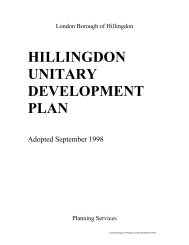Reluctant Gangsters - London Borough of Hillingdon
Reluctant Gangsters - London Borough of Hillingdon
Reluctant Gangsters - London Borough of Hillingdon
Create successful ePaper yourself
Turn your PDF publications into a flip-book with our unique Google optimized e-Paper software.
for a few months, usually in all-day ‘drinkers’, until the money ran<br />
out. By the late 1980s, however, improved security meant that it<br />
was becoming much harder to rob banks and post <strong>of</strong>fices, and the<br />
blaggers turned instead to a new and far more lucrative source <strong>of</strong><br />
easy money, drugs (Hobbs & Dunningham, 1998, KI.54).<br />
However, unlike the blags <strong>of</strong> yesteryear, the drugs business is a<br />
business, requiring a relatively elaborate division <strong>of</strong> labour within a<br />
large workforce, that must maintain and protect the supply chain;<br />
market, package and distribute the product, protect the key<br />
players, silence would-be whistle blowers, collect debts and ensure<br />
contract compliance. Moreover, it is in the nature <strong>of</strong> the drugs<br />
business that the numbers <strong>of</strong> people needed to run and protect it<br />
will increase until the market reaches saturation point, which it<br />
certainly had not by 2004 (Waltham Forest Drugs Audit 2004,<br />
2005). In consequence, in this period, there was a growing demand<br />
for young people with the requisite skills and disposition to fill<br />
vacancies in this burgeoning illicit labour market (KI.07,31).<br />
A Growing Market<br />
Indeed, in Waltham Forest, the trade in illicit drugs in general, and<br />
in opiates in particular, has been growing for the past five years at<br />
least. Until recently, however, most arrests and prosecutions have,<br />
been for cannabis trafficking and possession. Yet, throughout this<br />
period, ‘mergers and acquisitions’ in the expanding opiates market,<br />
normally facilitated by violence, have become commonplace (May,<br />
2004). While drug dealing appears to be what the 2004 Waltham<br />
Forest Community Safety and Drug Audit describes as a ‘high<br />
gain/low risk’ activity in the borough, more recent police action<br />
against drug-dealing gangs has led to more arrests for opiate<br />
dealing and seizures <strong>of</strong> the proceeds. However, the borough’s police<br />
are only able to deal with the drugs trade locally and, because the<br />
problem <strong>of</strong> class A. drugs has its origins well beyond the confines <strong>of</strong><br />
Waltham Forest, effective interdiction requires the co-operation <strong>of</strong>,<br />
and hence prioritisation by, national and international policing<br />
organisations and Customs and Excise.<br />
The Waltham Forest Drugs Market: The Upper Level<br />
Modern day drugs markets are segmented (see figure 4.1 below:<br />
which uses fictitious names to characterise the various suppliers in<br />
the upper level drug market). In the topmost echelon are the<br />
importers and wholesalers. Some <strong>of</strong> the crack-cocaine that reaches<br />
the borough is smuggled in large quantities directly from South<br />
America by established <strong>London</strong> crime families and distributed<br />
through their networks <strong>of</strong> ‘franchised’ dealers. The other source is<br />
Jamaica, where the cocaine business is said to constitute 40% <strong>of</strong><br />
GDP (Silverman, 1993, Figueroa & Sives, 2002). Cocaine imported<br />
21

















